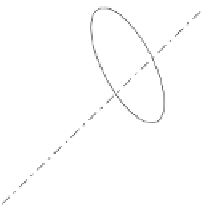Image Processing Reference
In-Depth Information
is, by nature, sub-optimal, we have to reach a compromise between the different quan-
tities involved. The basic case is when a prediction and an observation are available.
This is the case shown in Figure 2.1. The use of an extended Kalman filter amounts to
managing the respective weights attributed to the present observation and the predic-
tion function of the past and the prediction model. This filter is usually implemented
recursively. The time intervals between observations are not regular and this compro-
mise naturally has to be adapted to each new observation. The weight has to express,
of course, the confidence placed in each element of information.
Obviously, the problem gets more complicated when the number of sources of
information is greater than two. The simplest way to handle the process is to couple
several sensors mechanically on a same platform. Many such systems exist, for exam-
ple, two coupled cameras, a camera and a range-finder, a camera and a light projection
system. The same applies to signal processing. The system shown in Figure 2.4 is a
mechanical coupling between a radar and an FLIR which produces infrared labels.
When a plane is locked onto by a radar, it will perform maneuvers to evade tracking.
The usual way to do this is to use the artifacts of the single radar tracking algorithm.
When the trajectory is a straight line, the algorithm makes a compromise between the
weights of the observations and tracks, while maintaining a direction change detector
active. This detector reacts once it has 10 samples on the target. When the pilot begins
his maneuver, the plane is positioned so as to reflect as little energy as possible and
triggers a counter-measure system. The role of the infrared labels, in normal mode, is
to confirm the target's direction given the shape of the exhaust stream and, in direction
changing mode, the variation in shape of the exhaust stream can be used to conduct an
early detection and to provide information on changes in direction. In a way, the data
originating from one of the sensors supervises the overall process.
Figure 2.4.
Single platform coupling of two sensors















































Search WWH ::

Custom Search